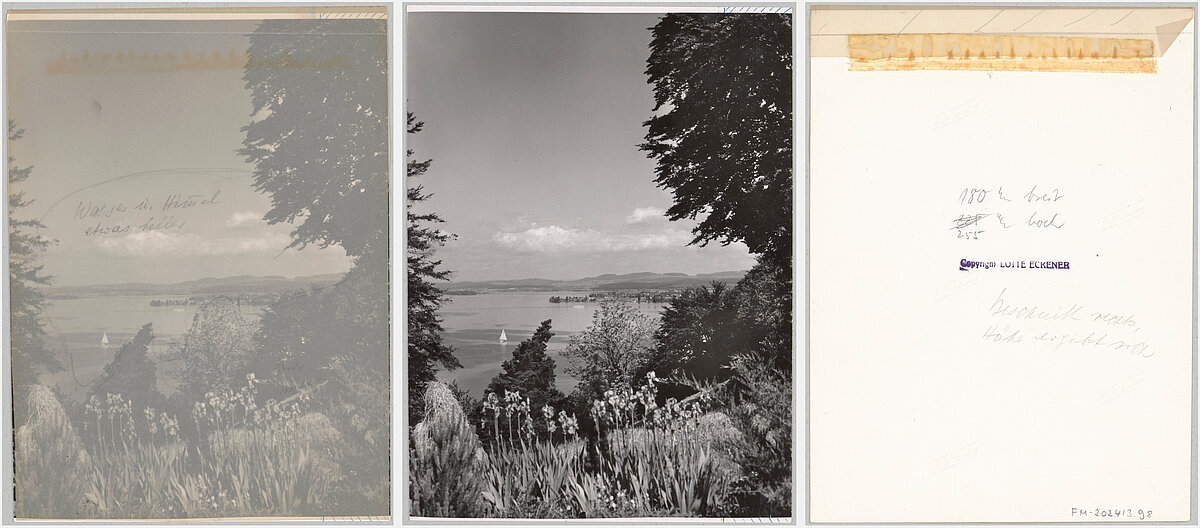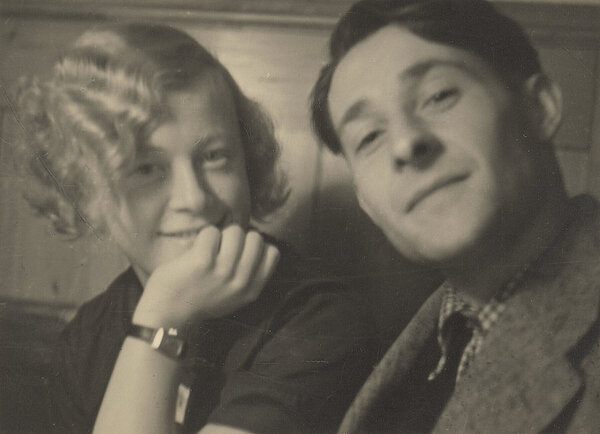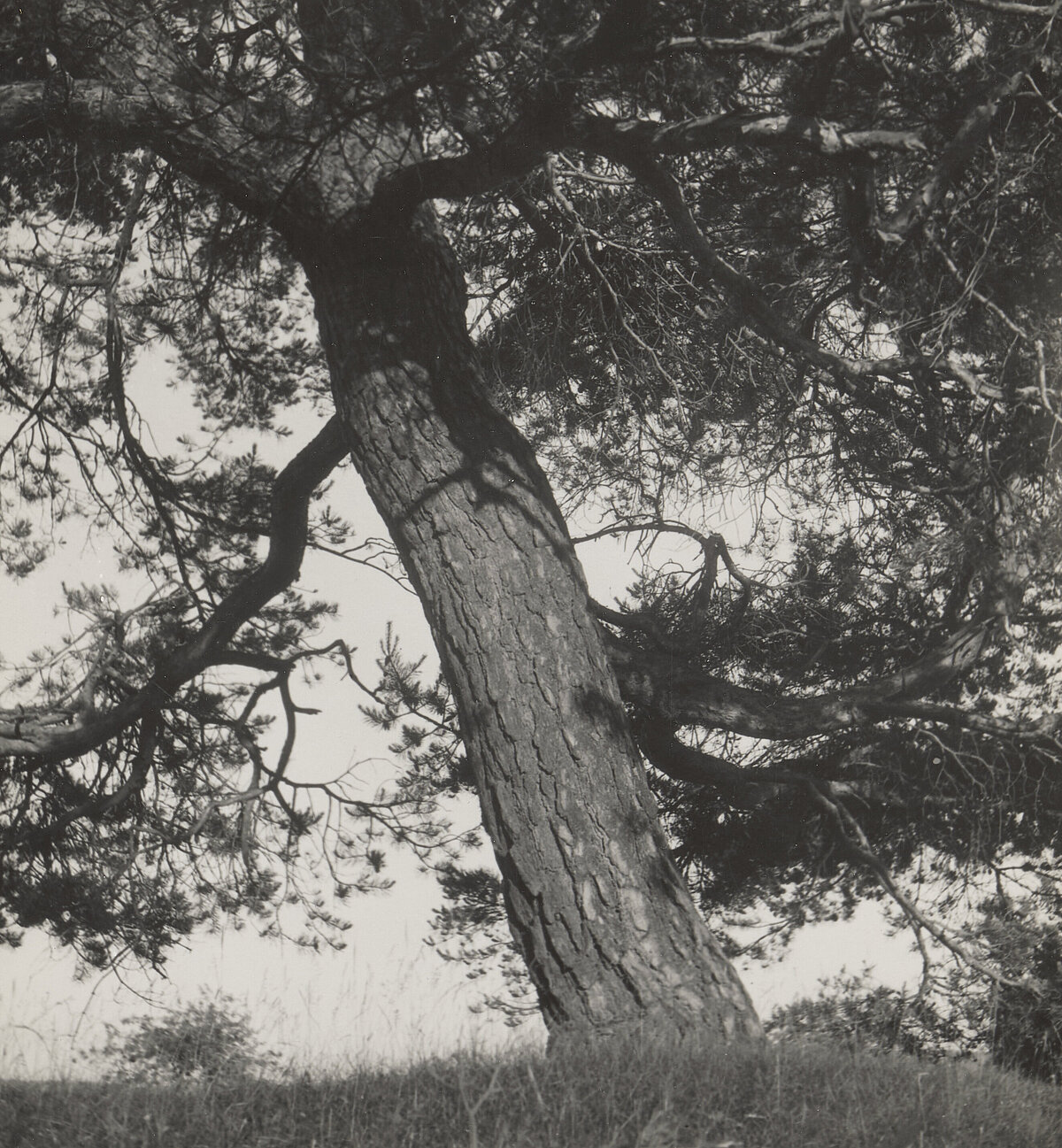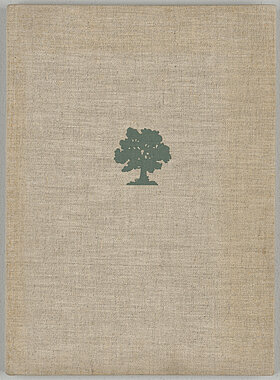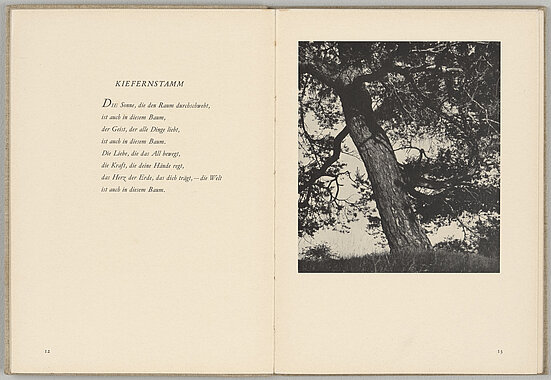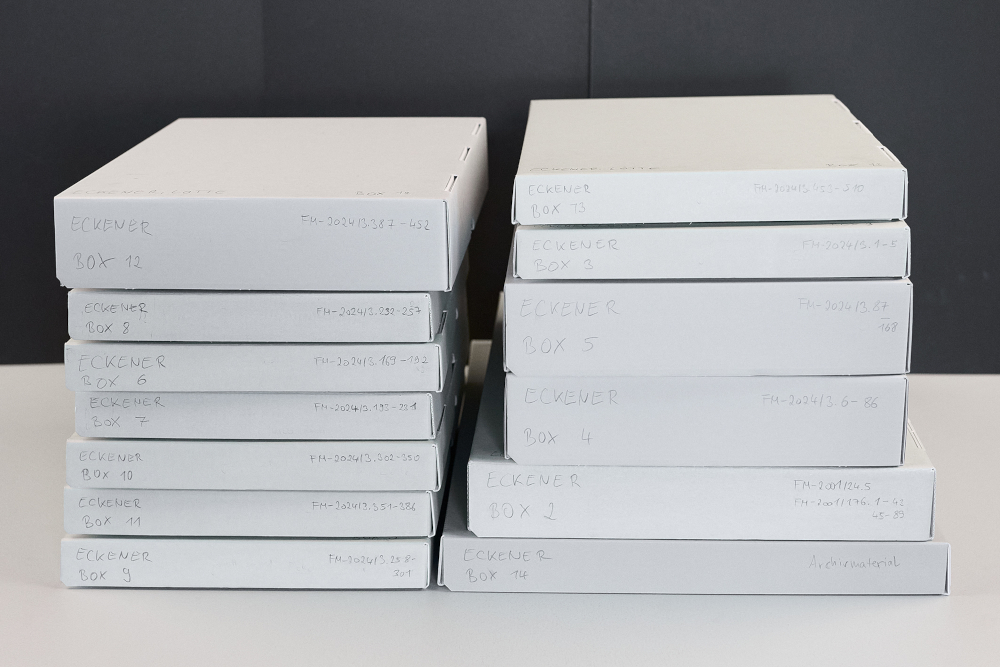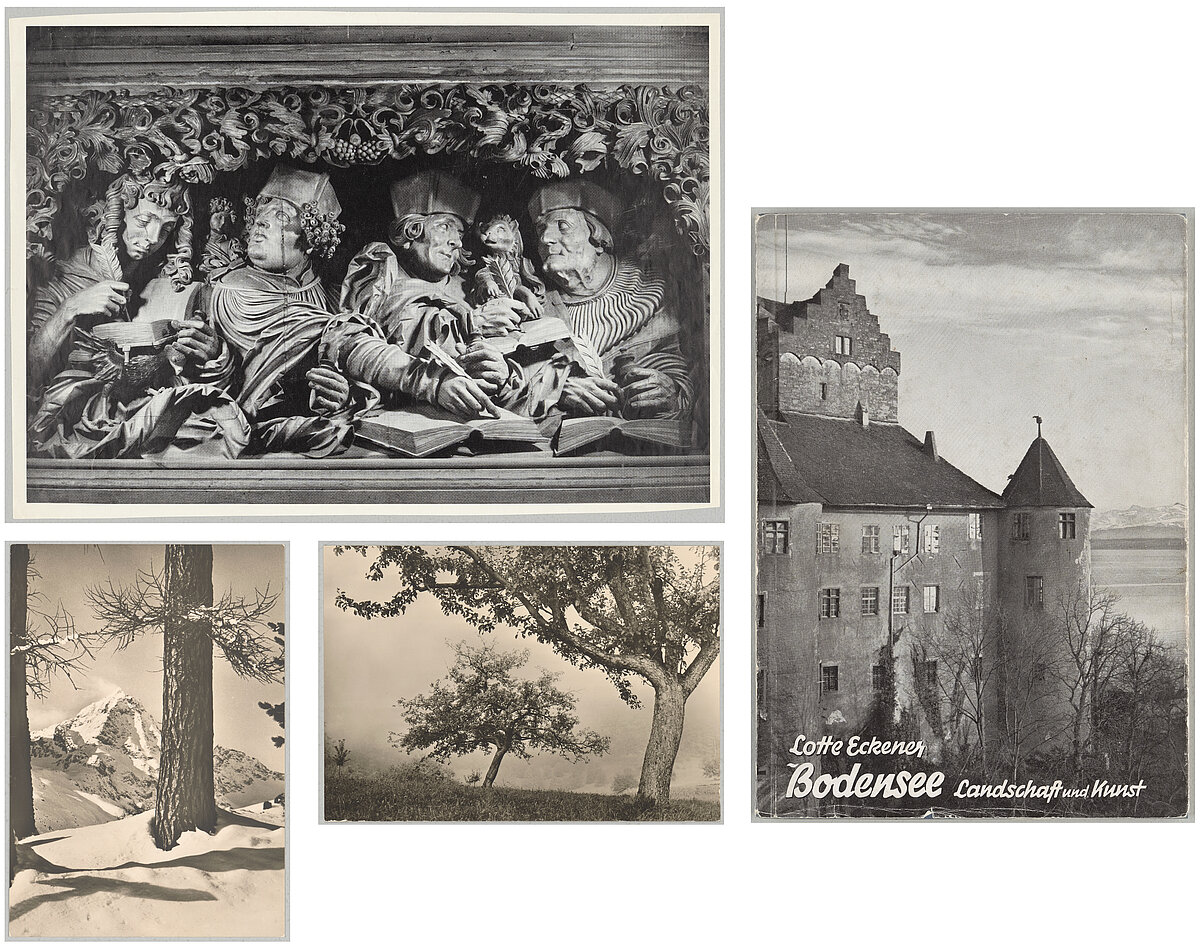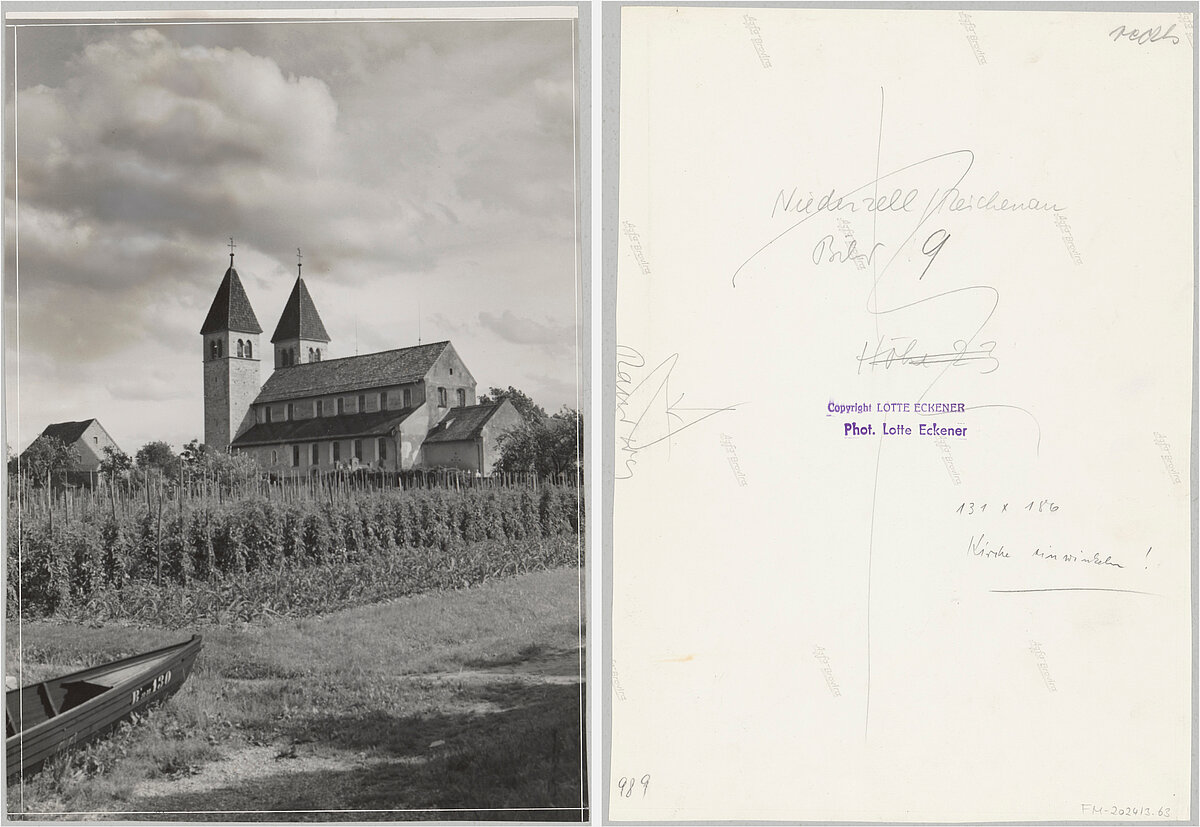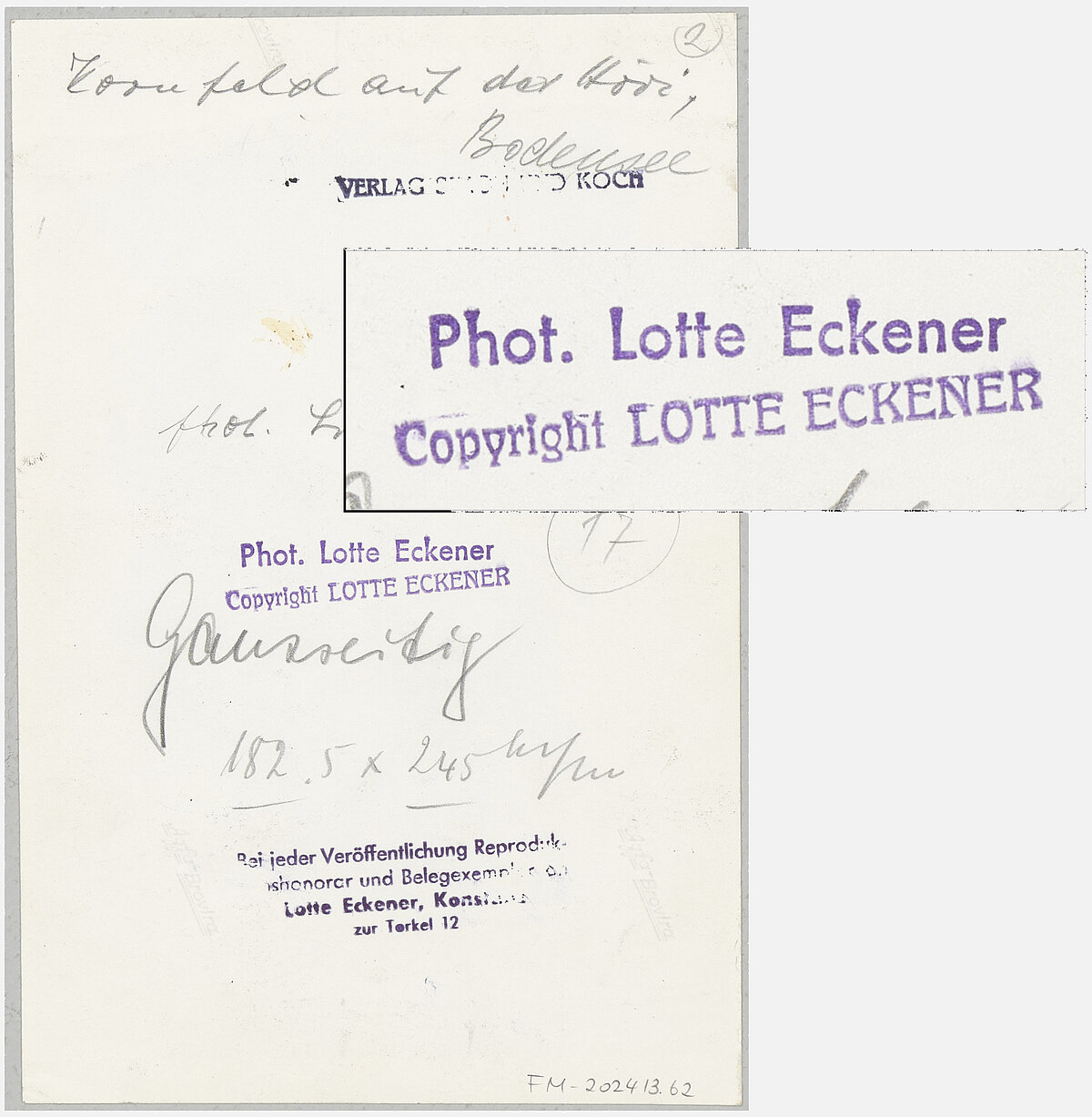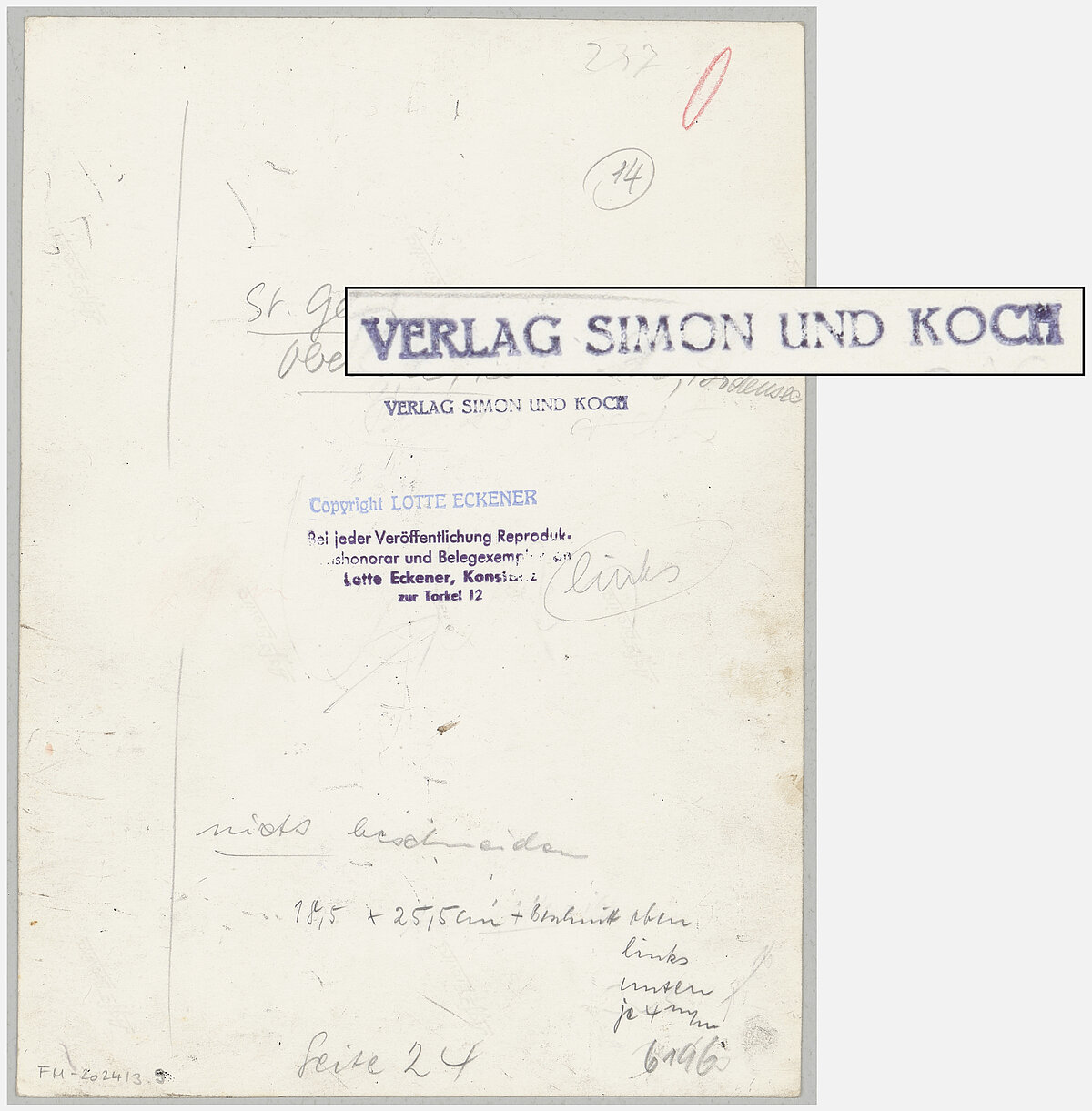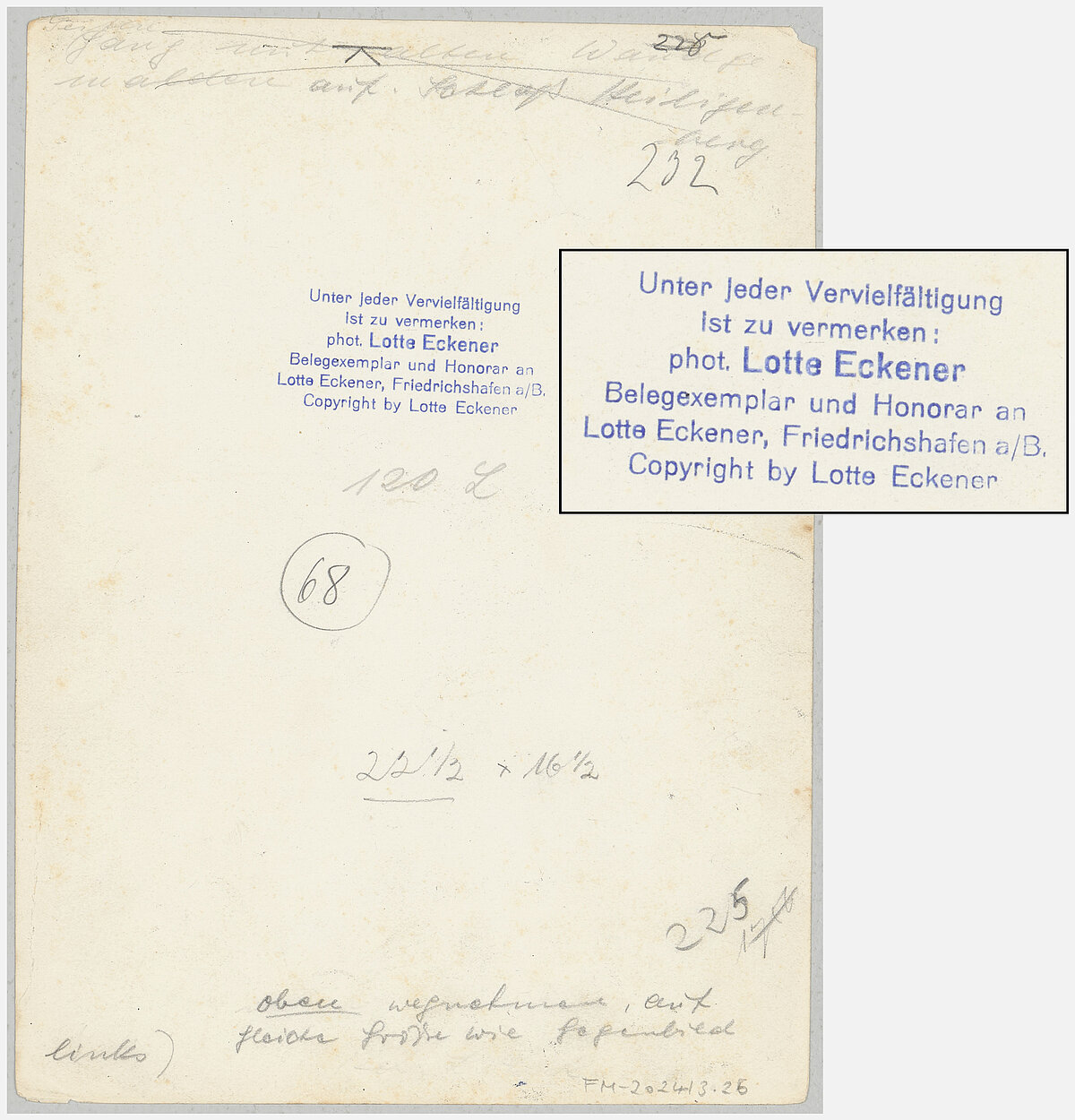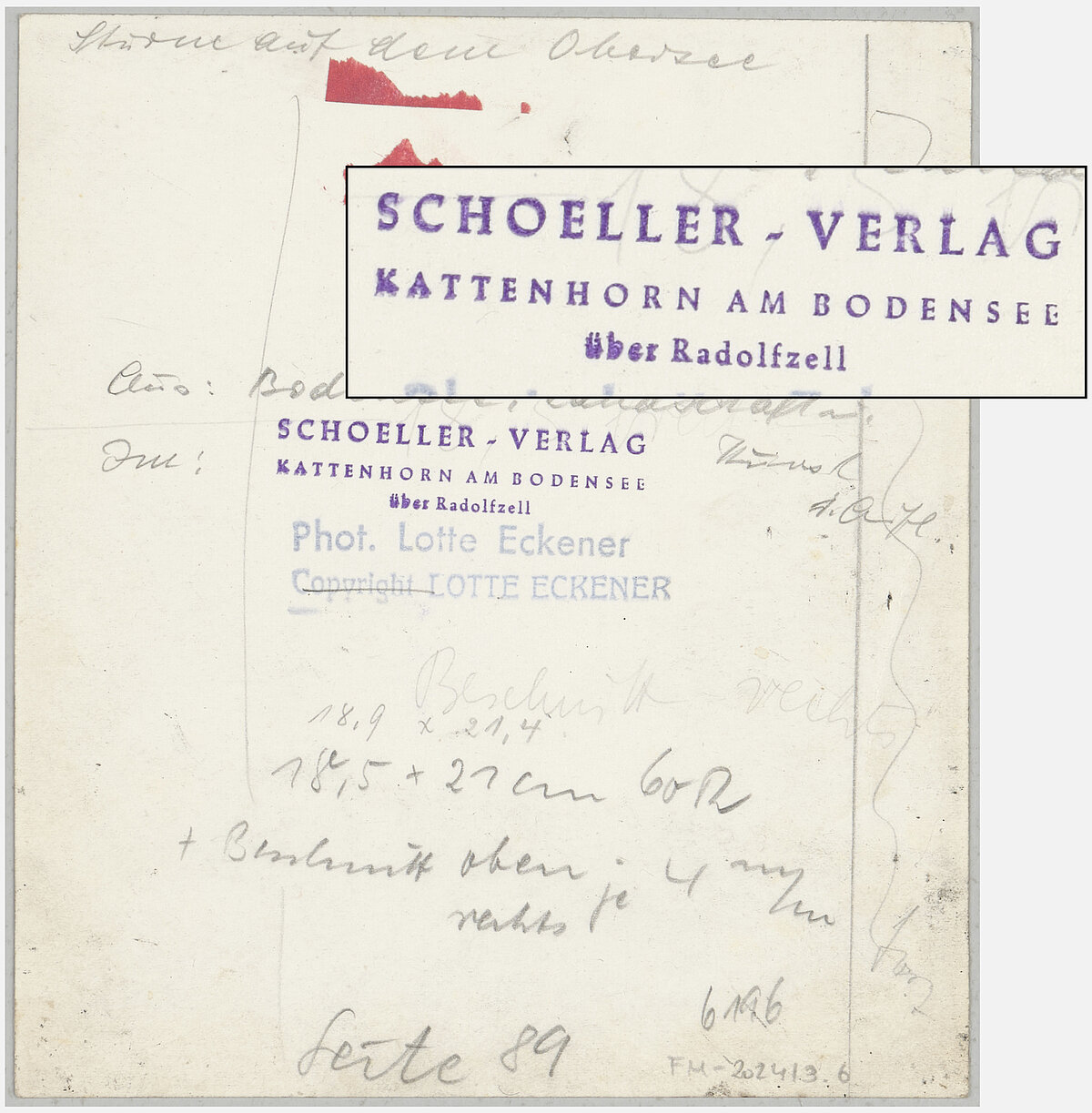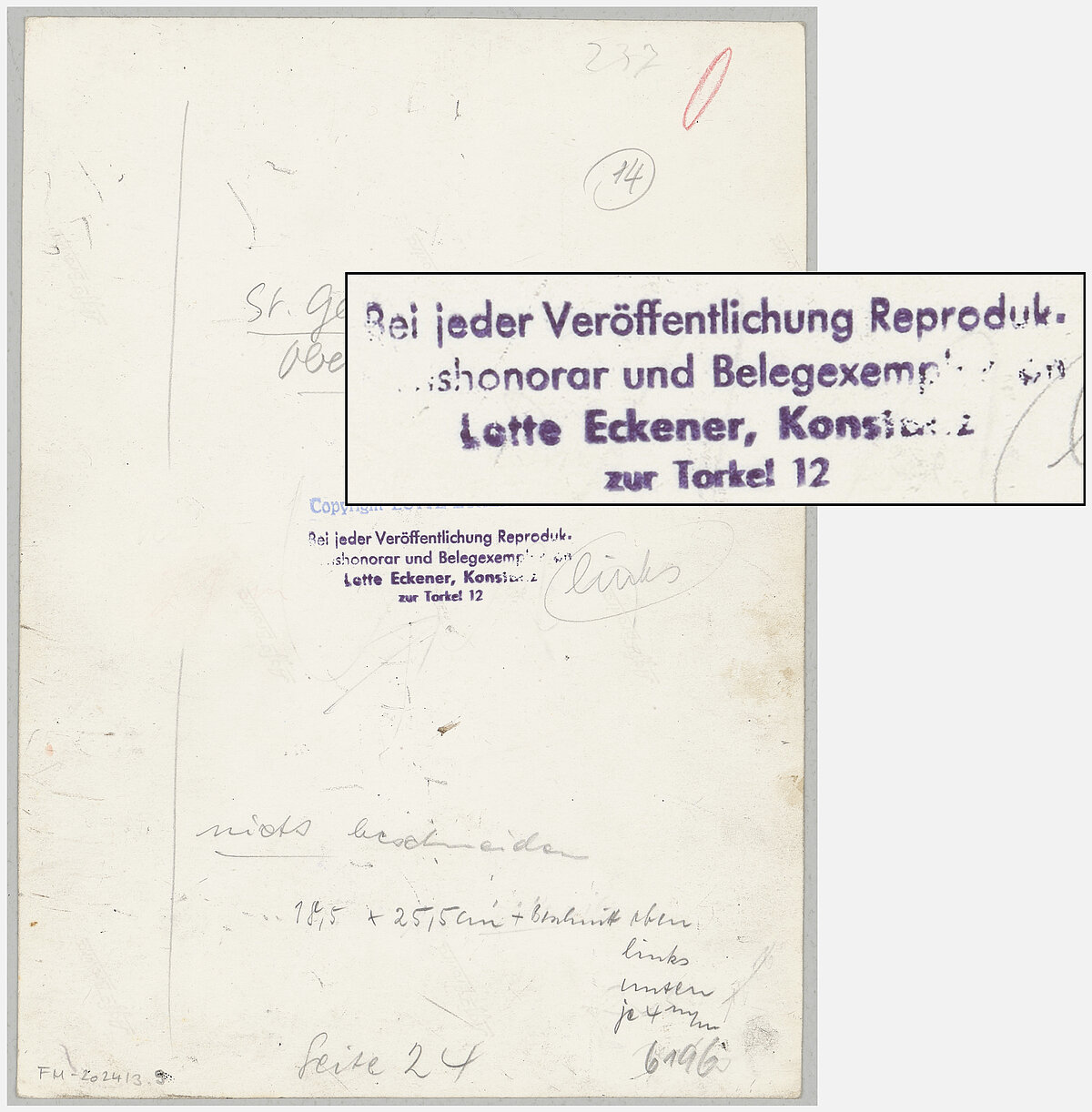Taken on the edge of a raised meadow, the photograph depicts a lake with a sailboat. The sky above is nearly cloudless. While there are flowers blooming on the lower edge of the photograph, trees frame the panorama view on the left and right edges. At first glance, the combination of lush greenery, open sky, and the still surface of the lake gives the scene the appearance of a nearly perfect idyll.
A closer look, however, reveals traces of editing in the blooms and stems of the flowers as well as crop marks on the right edge of the image. An attached sheet of transparent paper with notations such as “water and sky somewhat lighter” indicates that edits were planned to perfect the idyllic impression.
German photographer Lotte Simon-Eckener (1906–1995) took this photograph. The photography collection of the Münchner Stadtmuseum contains a total of just over six hundred photographs by Eckener; the works entered the collection from various sources. In conjunction with the exhibition Lehrjahre Lichtjahre: Die Münchner Fotoschule 1900–2000 (Apprenticeship Years Lightyears: The Munich Photo School 1900–2000), ten photographs were acquired in 2001 (inv. nos. FM-2001/24.1–9 and FM-2001/383); eighty-nine additional photographs were donated to the collection at that time (inv.-no. FM-2001/176.1–89).
Eckener’s inclusion in the exhibition Lehrjahre Lichtjahre: Die Münchner Fotoschule 1900–2000 (Apprenticeship Years Lightyears: The Munich Photo School 1900–2000) is due to her attendance of the school in the 1920s.
She subsequently worked in Berlin for several years in Alexander Binder’s photography studio, which mainly produced portraits and advertising photos. In the 1930s she returned to her hometown Friedrichshafen, and in 1936 moved to Constance, both of which are cities located on the shore of Lake Constance.
Among the photographs acquired in 2001 are images that were published in Eckener’s first photo book, including the image of a pine tree. Die Welt der Bäume (The World of Trees) was published by Berlin publisher Cassirer Verlag in 1933 with poems by Walter Bauer.[1]
Lotte Eckener in the Photography Collection of the Münchner Stadtmuseum
Lotte Eckener’s connection to Munich, which was shaped by her studies there, enriches the collection in many ways. In addition to the works of international photographers, the collection has a regional focus on southern Germany with photographers such as Regina Relang (1906–1989), Dimitri Soulas (b. 1938), and Stefan Moses (1928–2018). With her creative focus in the area around Lake Constance, Eckener strengthens the museum’s regional orientation. While Relang worked as a fashion photographer and both Soulas and Moses were primarily active as photojournalists, Eckener was devoted to landscape photography. In addition, Eckener’s photographs can be related to several thematic focuses of the collection: the printing history of photography, the photographic avant-garde of the postwar period, and travel photography, of which the holdings are considerable.
To date, presentations of Lotte Eckener’s photographs at the Münchner Stadtmuseum have only focused on her works from the 1920s, which were shown in three exhibitions and discussed in the accompanying catalogs.[2]
These include the Stillleben mit Gläsern und Zitronen (Still Life with Glasses and Lemons), which Katharina Täschner describes as an expression of Eckener’s “precise aesthetic sense of modern objects of everyday use.”[3] The exhibition Lotte Eckener: Tochter, Fotografin und Verlegerin (Lotte Eckener: Daughter, Photographer, and Publisher), which was shown in the Hesse Museum Gaienhofen in 2021 and the Museumsberg Flensburg in 2022, introduced Eckener to a broader audience. Simultaneously a book with the same title was published by curator and author Dorothea Cremer-Schacht and journalist Siegmund Kopitzki, whose biographical research is the basis for the present study on Eckener.[4]
Since 2001, in addition to the abovementioned photographs, the collection has contained a set of documents consisting of around 530 photographs and objects that have not been processed to date. While I was working on this study, these documents were officially donated by Eckener’s heir, her nephew Uwe Eckener, and subsequently catalogued (FM-2024/3.1–510), examined, and digitized by the collection. While most of the works are black-and-white prints, there are also twenty-one postcards, eight color photographs, one negative, seven contact sheets, and fourteen prints. Moreover, several copies of Eckener’s book on Lake Constance were added to the collection of the photography library. This set of documents represents the largest holdings of works by Lotte Eckener in a museum context: other photographs and materials, comprising negatives, postcards, and color photographs, are in a private collection. The online collection gives an overview of the holdings.
Printed Photography
According to statistics gathered by the German trade association in 1951, 130 thousand women owned studios, which amounts to one seventh of all studio owners.[5] Lotte Eckener was probably not included in these statistics, since she did not possess her own studio at any time during her entire career between the 1920s and the 1970s. Eckener also remained in the background in other areas that provided a platform to women photographers—such as membership in clubs and participation in solo or group shows.[6] Her preferred medium was the photo book, particularly the book Bodensee: Landschaft und Kunst (Lake Constance: Landscape and Art), which according to Dorothea Cremer-Schacht was published in fourteen editions between 1935 and 1963.[7]
The set of documents relating to Lotte Eckener at the Stadtmuseum includes different photography-based materials: prints and postcards, printed matter and photo books. What these formats have in common is that they all represent photography as printed images.
Every day we encounter photography as a medium in various formats. Since the 1920s—before the spread of the smartphone and the circulation of interlinked images on the internet—the most common point of contact with photography was the printed image, ranging from newspapers, magazines, and calendars to brochures, posters, postcards, and photo books. Lotte Eckener’s photographs mark a starting point for understanding the transfer from photographic prints to printed images. This requires examining the individual objects not only on the visual level but also in terms of their materiality.
An Approach Based on the History of Materials
Over the past decades, various academic fields, including art history, have increasingly paid attention to the materiality of objects. In the history of photography, the influence of technical processes and devices such as different cameras has long been recognized. An approach based on the history of materials, as is practiced by scholars such as British anthropologist and photo historian Elizabeth Edwards, evaluates the material aspects of photographs, their production processes, their distribution, and their role in both social and historical contexts.[8]
The material history of the photographs is central to an investigation of Lotte Eckener’s work, in which both the front and back of the images are significant. The front sides predominantly depict motifs from the area around Lake Constance and include around 120 duplicates—that is, motifs that are available in different versions and formats. The retouching that is visible in several prints is characteristic: branches are darkened using ink, snow is brightened, and clouds are added or removed with extensive overpainting. In addition, cropping lines are marked on the pictures.
These revisions often correspond with the notes and instructions on the backs of the photographs or on attached sheets of tracing paper. These include handwritten notation that propose changes to certain visual aspects or provide additional information on dimensions, cropping lines, or positioning for printing. In the video, artist and book designer Helmut Völter talks about the working processes that can be seen in Lotte Eckener's photographs.
The retouching, comments, and duplicates suggest that these photographs served as working material. Since there is no retouching on the privately owned negatives, it can be concluded that Lotte Eckener worked primarily with the prints. By examining different prints or the relationship to the publications, it is revealed how these modifications were implemented. An approach using the history of objects makes it possible to better understand the formative and editing processes of Eckener’s photographs.
Stamps as a Source
In addition to retouching, cropping, and commentary, the backs of the photographs contain an additional feature that provides important information about Eckener’s work. Stamps can serve as sources: they testify to the authorship, make it possible to classify the date or location, give insight into political contexts, and show something about the development of the stamp itself. Lotte Eckener’s stamps are explained in the audio commentaries.
Although the holdings pertaining to Lotte Eckener are rather small in comparison with the overall volume of the photography collection at the Münchner Stadtmuseum, it is valuable to process and investigate the material in it because there are conclusions to be made about media practices concerning photography in the mid-twentieth century. That is why three other articles are dedicated to the development of Eckener’s book on Lake Constance, its significance in tourism discourse in the postwar era, and the role and reception of Lotte Eckener within the context of photography in the Lake Constance region in the postwar period.
Endnotes
[1] Walter Bauer (1904–1976) was a German writer who was promoted by the editor-in-chief of the publisher Bruno Cassirer Verlag. Following the seizure of power of the Nazi party in 1933, he was temporarily forbidden to write and his books before 1933 were no longer published. See Günther Hess, Walter Bauer: Ein Lebensweg von Merseburg nach Toronto (Halle an der Saale: Mitteldeutscher Verlag, 2018).
[2] See Ulrich Pohlmann and Rudolf Scheutle, eds., Lehrjahre Lichtjahre: Die Münchner Fotoschule 1900–2000, exh. cat., Fotomuseum im Münchner Stadtmuseum, Munich (Munich: Schirmer/Mosel, 2000), 96–97 and 261; Ulrich Pohlmann, ed., Stilles Leben 1910–2008: Wenn die Dinge träumen; Stillleben aus der Sammlung Fotografie, exh. cat., Münchner Stadtmuseum, Munich (Munich, 2008), 11 and 19; the exhibition Welt im Umbruch was shown in Munich in 2020–21, but Lotte Eckener is not mentioned in the catalog; see Kathrin Baumstark, and Ulrich Pohlmann, eds., Welt im Umbruch: Kunst der 20er Jahre, exh. cat., Bucerius Kunstforum, Hamburg; Münchner Stadtmuseum, Munich (Munich: Hirmer, 2019).
[3] Katharina Täschner, “Entschleunigung der Dinge,” in Frauke von der Haar und Lothar Schirmer, eds., Ulrich Pohlmann: Fotografie sammeln 1991–2022 (Munich: Schirmer/Mosel, 2023), 150–51.
[4] Dorothea Cremer-Schacht and Siegmund Kopitzki, eds., Lotte Eckener: Tochter, Fotografin und Verlegerin, Kleine Schriftenreihe des Stadtarchivs Konstanz 22, ed. Jürgen Klöckler (Munich: UVK Verlag, 2021).
[5] Anonymous, “Frauen im Handwerk,” Photo-Presse 6, no. 13 (1951): 7.
[6] See Bolin, Clara, “Wo sind sie? Fotografinnen in den 1950er Jahren: Gespräch mit Dorothea Cremer-Schacht, Stefanie Grebe, Thomas Morlang und Ina Neddermeyer zu Forschungsstand und Forschungslücken,” in “Vom Lichtbild zum Foto: Zur westdeutschen Fotoszene der 1950er Jahre,” special issue, Fotogeschichte 43, no. 169 (2023): 43–51.
[7] All details from the biography of Lotte Eckener are from Cremer-Schacht and Kopitzki, Lotte Eckener, 229.
[8] Elizabeth Edwards and Janice Hart, “Photographs as Objects,” in Edwards and Hart, eds., Photographs Objects Histories: On the Materiality of Images (New York and London: Routledge, 2004), 1–15, esp. 1.
About the author
Clara Bolin is an art and photography historian. Between 2023 and 2025, she serves as a fellow in the Museum Curators for Photography program of the Alfried Krupp von Bohlen und Halbach-Foundation, working within the Münchner Stadtmuseum’s Photography Collection. Her interest in Lotte Eckener builds on earlier projects focused on post-war photography and the role of women photographers.
Date of pubishing
June 27, 2024
Translation by Tas Skorupa
Plan Your Visit
Opening hours
Although the Münchner Stadtmuseum's exhibitions closed on January 8, 2024, for a complete renovation, the cinema and the Stadtcafé will remain open to visitors until June 2027.
Information to Von Parish Costume Library in Nymphenburg
Filmmuseum München – Screenings
Tuesday / Wednesday 6.30 pm and 9 pm
Thursday 7 pm
Friday / Saturday 6 pm and 9 pm
Sunday 6 pm
Contact
St.-Jakobs-Platz 1
80331 München
Phone +49-(0)89-233-22370
Fax +49-(0)89-233-25033
E-Mail stadtmuseum(at)muenchen.de
E-Mail filmmuseum(at)muenchen.de
Ticket reservation Phone +49-(0)89-233-24150

